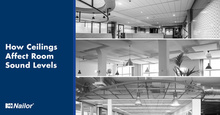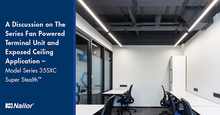Nailor Airwaves is your source for content on relevant topics concerning Nailor Industries, Inc. and the HVAC industry. New product releases, case studies, product & project spotlights, employee interviews, trade publication articles, and general announcements are some of the content types you can expect to find in the Nailor Airwaves.
Nailor Airwaves
UFAD vs. Displacement

Both Underfloor Air Distribution (UFAD) and Displacement Air Distribution are well defined in the 2021 ASHRAE Handbook Applications, Chapter 20, Space Air Diffusion. Generally, the idea for UFAD is to have a well-mixed lower level in the occupied space up to about 4.5 feet above the floor. From the thermocline at 4.5 feet to about 3 to 5 inches from the ceiling is a stratified space. Above the Stratified space, the upper region is the warmest and most polluted air in the room. It is being induced into the return air space or ducts at the ceiling and returned to the air handler. UFAD diffusers are typically designed to mix the space air with the supply air very rapidly to eliminate any uncomfortable areas due to the colder air. Generally, the same amount of air as an overhead fully mixed… Read more
How Ceilings Affect Room Sound Levels

Area SourceWhen a room has a full ceiling stretching from wall to wall, the ceiling isolates the room from the area above the ceiling. Frequently that space above the ceiling is used for the return air path to the air handler. It is also used to mount mechanical equipment, plumbing, electric supplies and lighting. The open space is a separate space from the occupied area below. As such, sound that is generated in the return plenum spreads throughout the plenum and produces an area sound source that emanates across the entire ceiling somewhat evenly into the space below. AHRI Standard 885 describes how the sound from the mechanical equipment is affected as it enters the occupied space. Sound readings in the occupied space will be nearly constant across the entire floor area in the room.… Read more
Fan Powered Terminal Units – Model Series 35SXC Stealth XC

Acoustical Privacy in Exposed Ceiling Applications
Architectural designs with open offices and acoustical tile suspended ceilings often have relatively low sound level requirements to achieve “acoustical privacy” for the occupants. The acoustical design goals include controlling occupied space noise levels so that it is neither so loud as to interfere with speech or too quiet so that all intermittent sounds become a distraction. Acoustical specifications have included several measures including Octave Band Sound levels, NC (Noise Criteria, based on a tangent maximum referenced to a chart of average human response), RC (Room Criteria, the average is 500 thru 2000 Hz bands and a letter representing high or low frequency predominance) and DbA (an “A Scale” weighted Log Sum in all bands).… Read more
How Ceiling Diffusers are Selected

The ultimate goal of an air distribution system is to uniformly deliver conditioned air into a room. A good diffuser setup mixes the air in the room while maintaining comfort for as many people as possible. An ineffective setup can cause drafty air, dead zones without proper mixing, or excessive noise. While most engineers understand the basics of how to select and place diffusers, we often see mistakes that could be avoided with a better understanding of air diffuser design.
Selection Criteria
To select diffusers for a room, an engineer first calculates the required cooling or heating load from the local environment, construction, and ventilation requirements defined by ASHRAE 62.1. This standard defines the ventilation load, which is usually 3 times less than the cooling/heating load in… Read more
Fan Coil Units: High Capacity Horizontal

While the in-room horizontal fan coils units may be the highest volume product used in the industry due to the numbers used in hospitality, the high-capacity horizontal fan coil units are the most versatile. The span of sizes, options, and variants make these units suited for residential, office, & industrial applications. High-capacity refers to the larger sizes up to 4,000 CFM and the ability of the fans to handle 3/4" w.g. of static pressure. Both allow for more complex ductwork and air distribution than other designs. Learning how each of the components in the construction works together to deliver comfort will help select the best product for your application.
5 Consideration Variables
The previous article highlighted the five variables to consider when selecting a horizontal fan… Read more